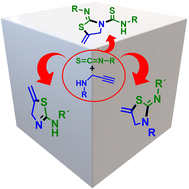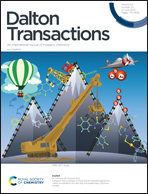Catalysis-free synthesis of thiazolidine–thiourea ligands for metal coordination (Au and Ag) and preliminary cytotoxic studies†
Abstract
The reaction of propargylamines with isothiocyanates results in the selective formation of iminothiazolidines, aminothiazolines or mixed thiazolidine–thiourea compounds under mild conditions. It has been observed that secondary propargylamines lead to the selective formation of cyclic 2-amino-2-thiazoline derivatives, while primary propargylamines form iminothiazoline species. In addition, these cyclic thiazoline derivatives can further react with an excess of isothiocyanate to give rise to thiazolidine–thiourea compounds. These species can also be achieved by reaction of propargylamines with isothiocynates in a molar ratio of 1 : 2. Coordination studies of these heterocyclic species towards silver and gold with different stoichiometries have been carried out and complexes of the type [ML(PPh3)]OTf, [ML2]OTf (M = Ag, Au) or [Au(C6F5)L] have been synthesised. Preliminary studies of the cytotoxic activity in lung cancer cells have also been performed in both ligands and complexes, showing that although the ligands do not exhibit anticancer activity, their coordination to metals, especially silver, greatly enhances the cytotoxic activity.



 Please wait while we load your content...
Please wait while we load your content...